






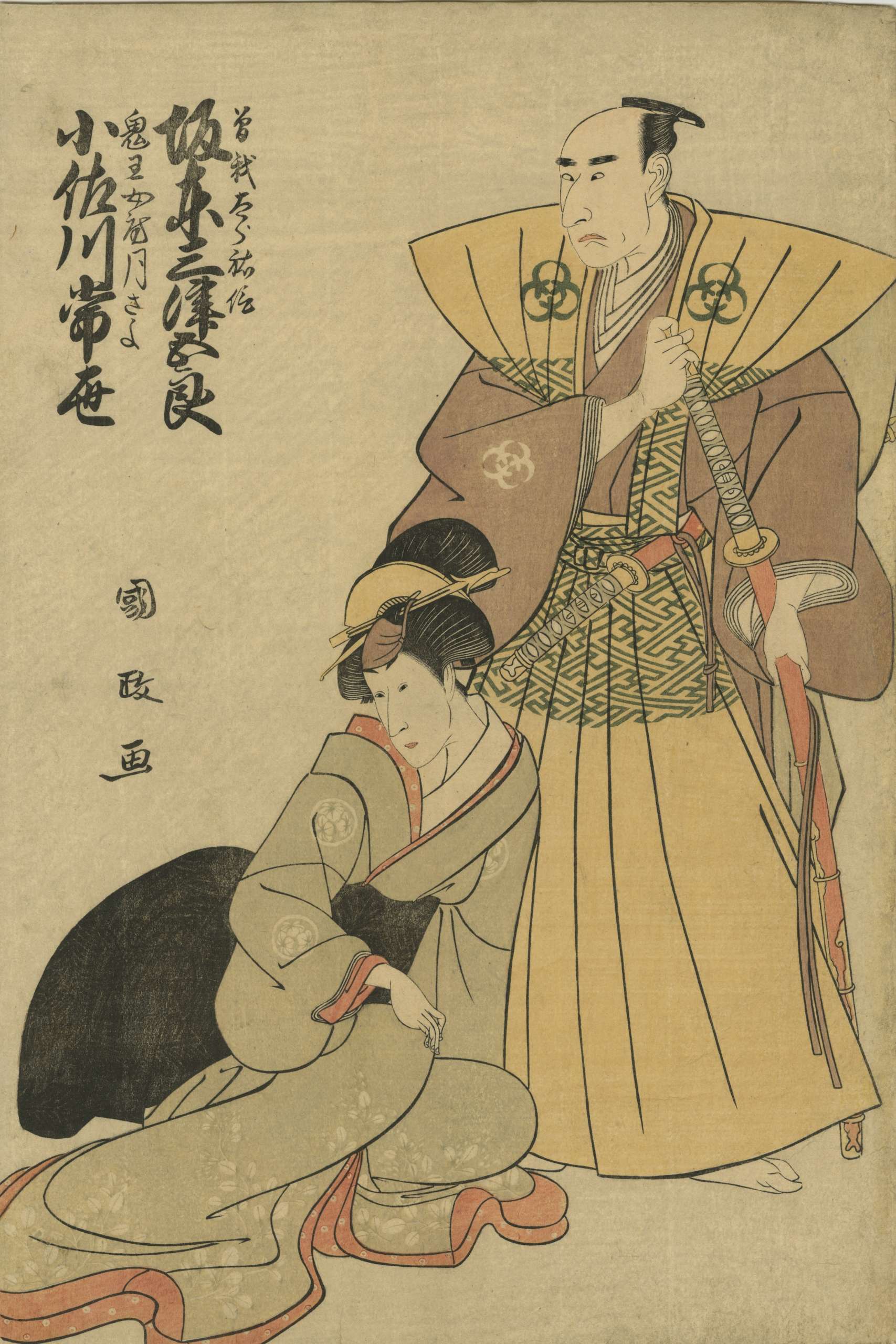


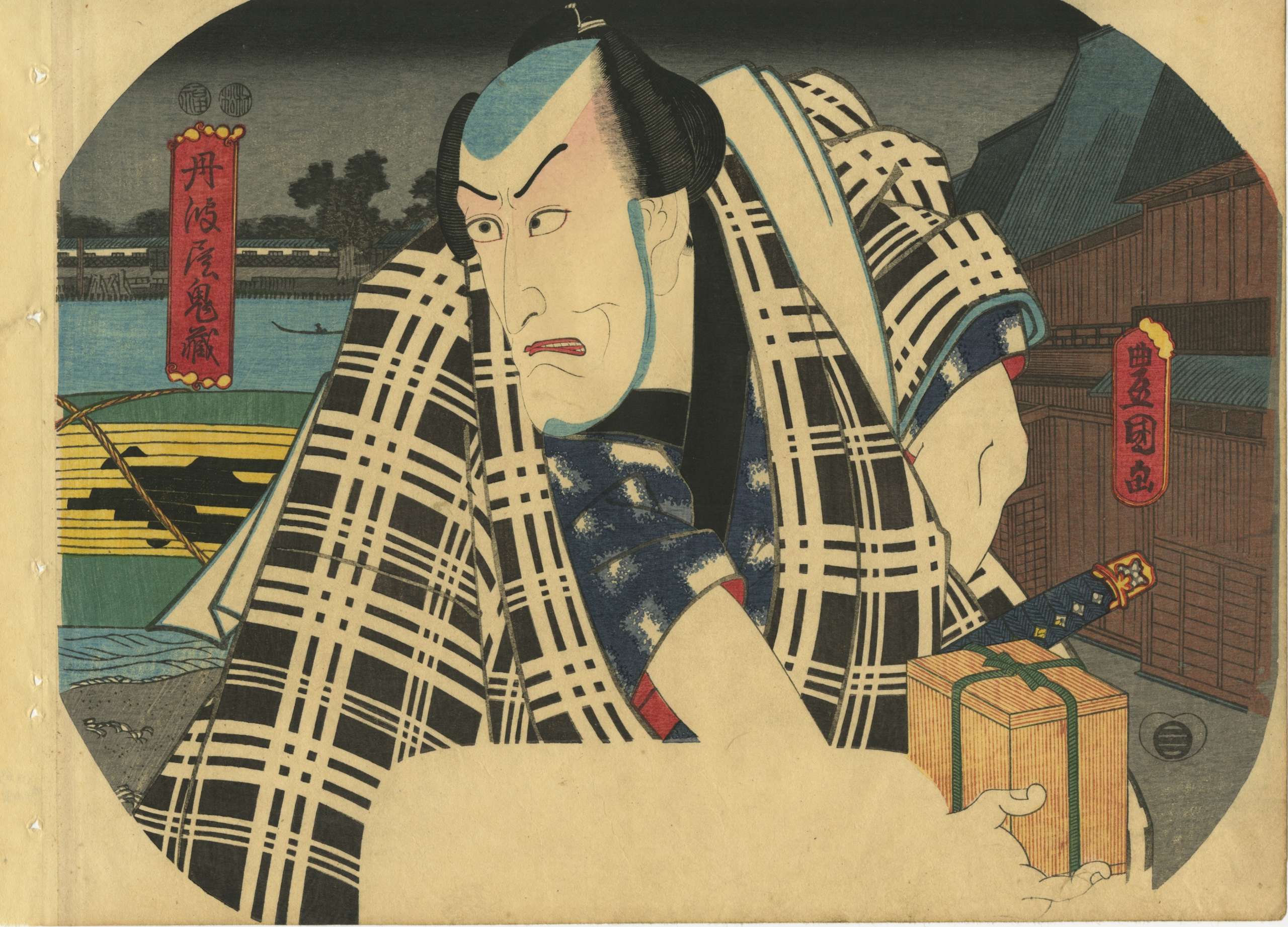





 Other prints from the same series in this collection:
SVJP-0343.2021 — Tamagiku:
Other prints from the same series in this collection:
SVJP-0343.2021 — Tamagiku:
 SVJP-0400.2023 — Saiko:
SVJP-0400.2023 — Saiko:
 Note: Special thanks to Horst Graebner, who helped decipher and understand the meaning.
Note: Special thanks to Horst Graebner, who helped decipher and understand the meaning.
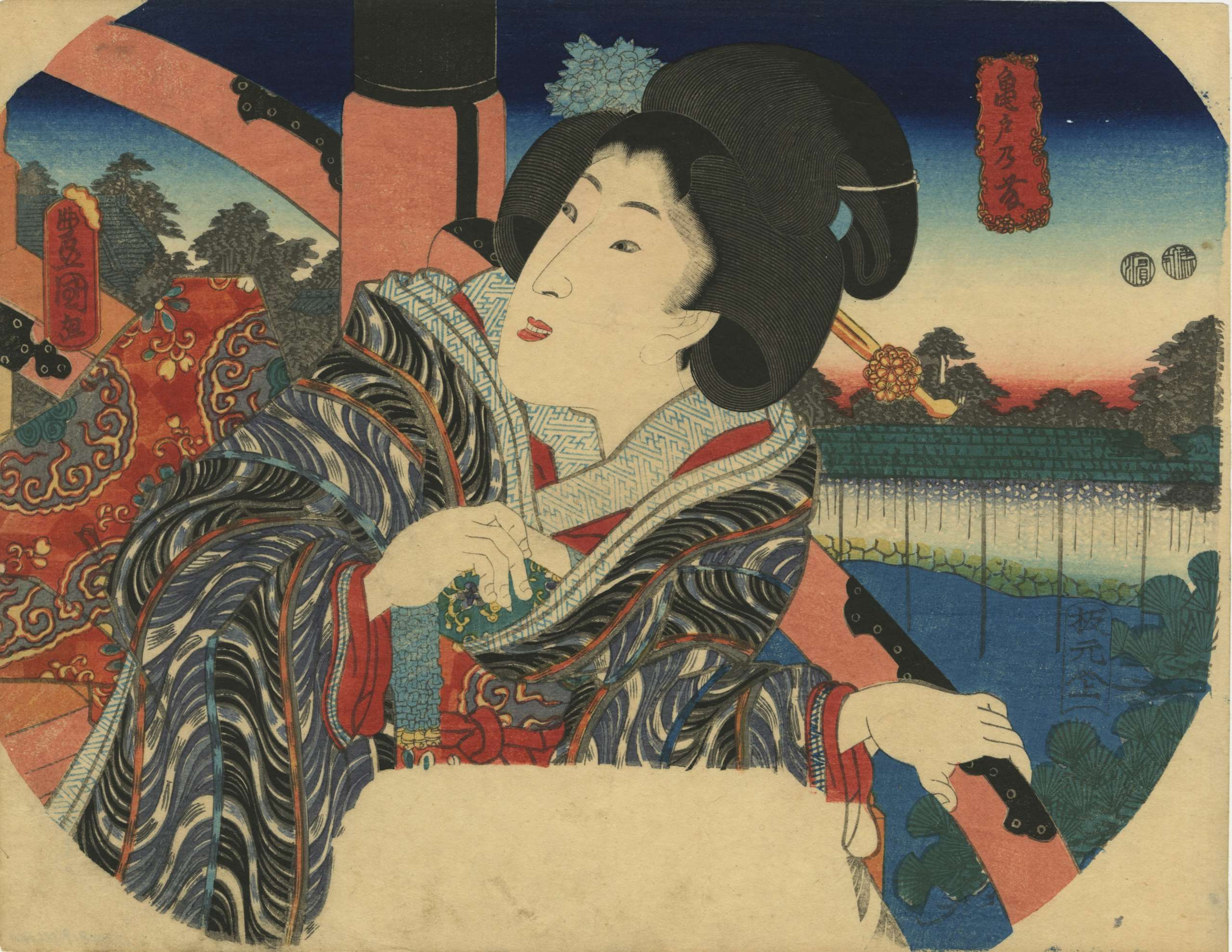

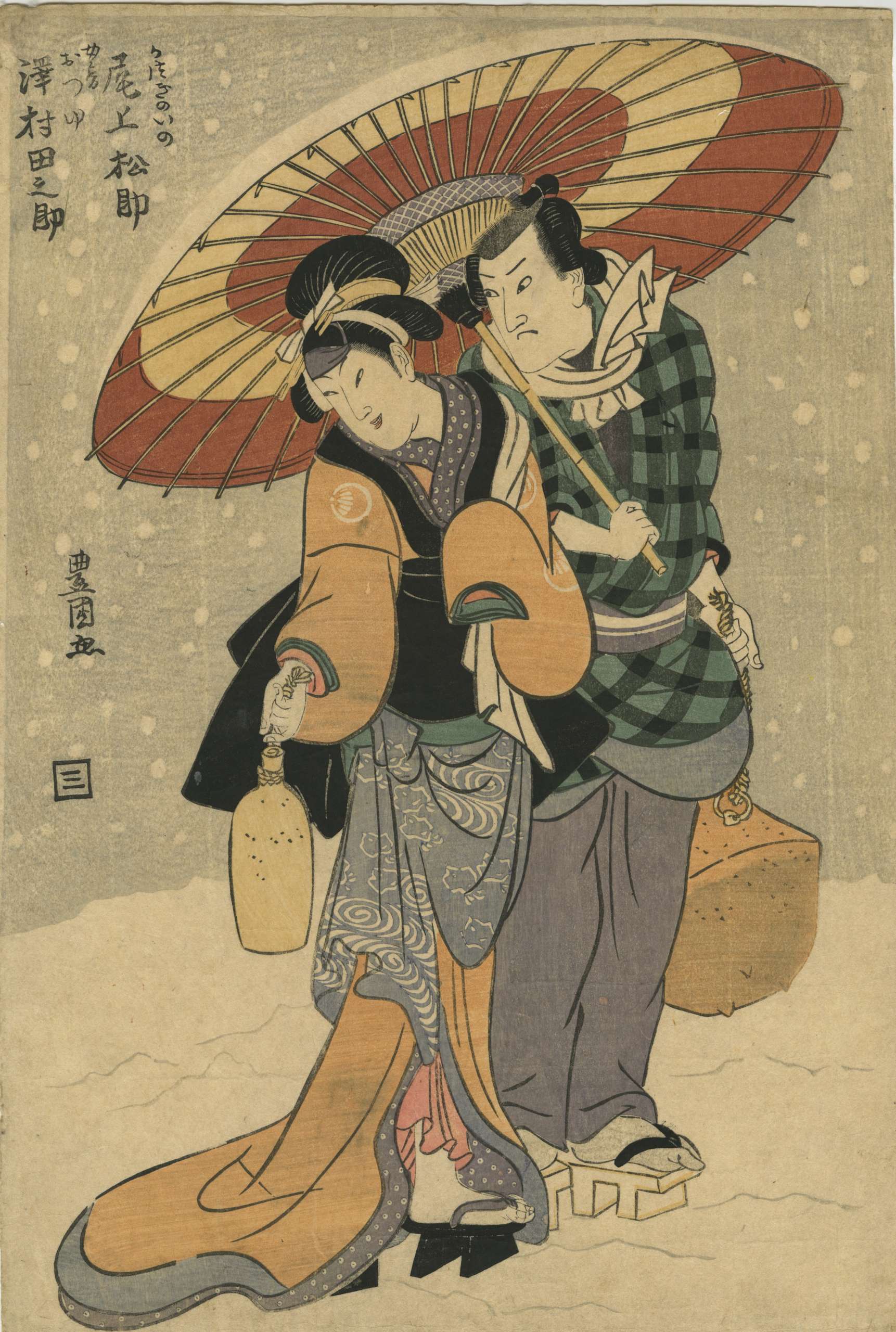

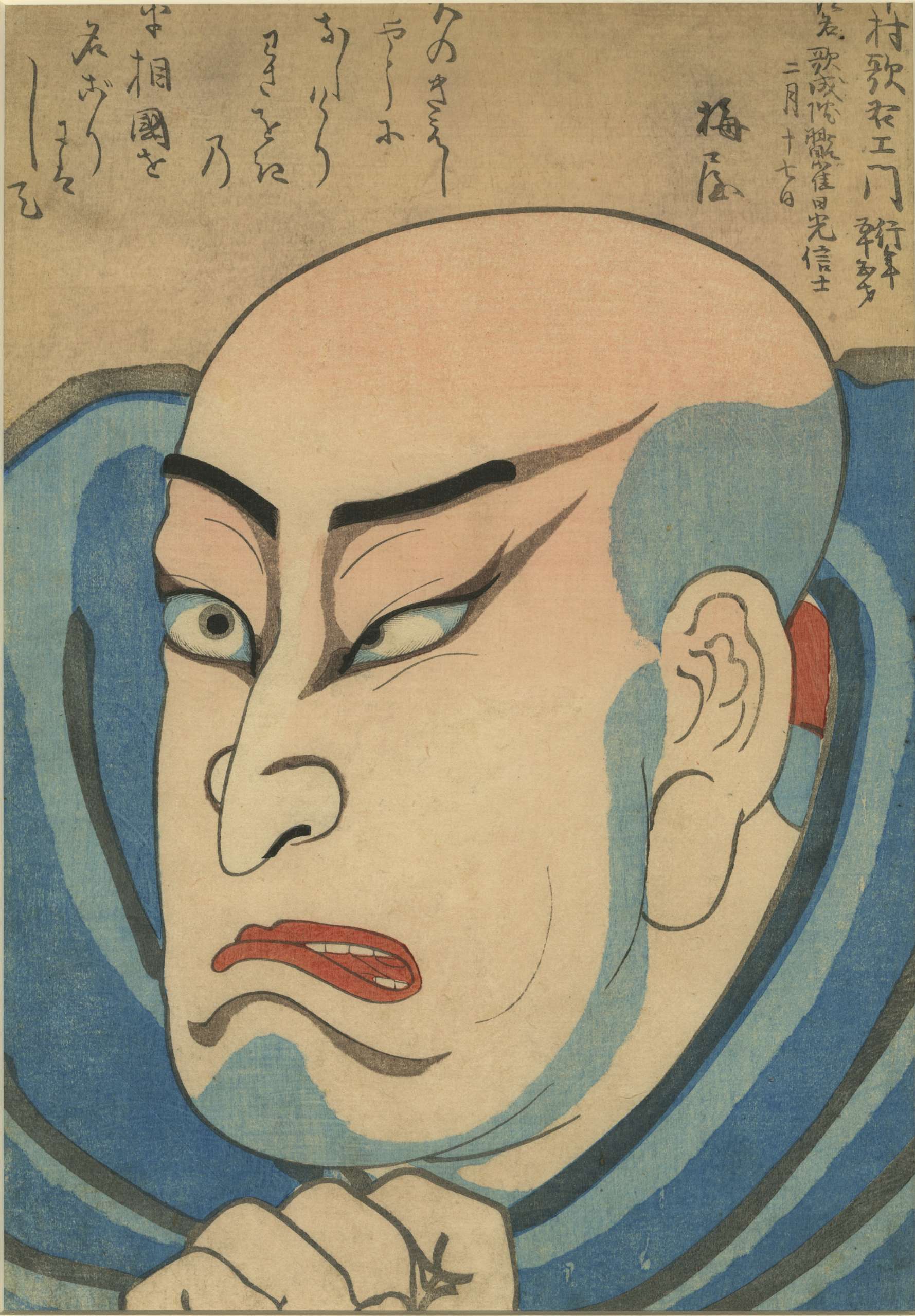






Segawa Kikunojō III (Japanese, 1751 – 1810); other names: Segawa Senjo, Segawa Rokō III, Segawa Tomisaburō I, Ichiyama Tomisaburō, Ichiyama Shichinosuke. The actor held the name of Segawa Kikunojō III from the 11th lunar month of 1774 to the 7th lunar month of 1801. He surpassed all the actors of his time in both female and male roles, especially in the former, and achieved tremendous public acclaim.
Arashi Hinasuke II [嵐雛助] (Japanese, c. 1774 – 1801); other names: Nakamura Jūzō III, Kanō Hidenosuke I, Arashi Hidenosuke I. The actor held the name of Arashi Hinasuke II from the 1st lunar month of 1794 to the 2nd lunar month of 1801. Hi died in Edo on the 4th day of the 2nd lunar month of 1801. For the same characters illustrated by Utagawa Kuniyoshi see SVJP-0333.2021. Sources:
Sources:

 №1: "...one of the most exotic scenes in all shunga. A Dutch kapitan is discovered coupling with a lovely Japanese courtesan, beside a large window opening upon a garden...".
№1: "...one of the most exotic scenes in all shunga. A Dutch kapitan is discovered coupling with a lovely Japanese courtesan, beside a large window opening upon a garden...".

 №2: "...a fair young harlot is seen masturbating with a grinding-pestle - a man watches intently from under bedding." [I have two specimens of this design; the one from album is more soiled but less faded].
№2: "...a fair young harlot is seen masturbating with a grinding-pestle - a man watches intently from under bedding." [I have two specimens of this design; the one from album is more soiled but less faded].
 №3: "...the artist has effectively contrasted the lovers by depicting the man's face as seen through the geisha's gauze skirt. [...] we are impressed more by strikingly elegant composition, the dramatic coloring, rather than feeling any great urge to participate in the energetic proceedings..."
№3: "...the artist has effectively contrasted the lovers by depicting the man's face as seen through the geisha's gauze skirt. [...] we are impressed more by strikingly elegant composition, the dramatic coloring, rather than feeling any great urge to participate in the energetic proceedings..."
 №4: "This scene is a most straightforward one, featuring the standard Missionary Position [capitalization by R. Lane].; but withal, the contrast of the young and naked, secret lover and the richly-clothed courtesan amid luxurious bedding..."
№4: "This scene is a most straightforward one, featuring the standard Missionary Position [capitalization by R. Lane].; but withal, the contrast of the young and naked, secret lover and the richly-clothed courtesan amid luxurious bedding..."
 №5: "In a striking lesbian scene (which has no equivalent in Utamaro, and is, incidentally, often omitted in later editions of this album), the girl at left prepares to receive the harikata (dildo) worn by the older girl at right (who holds a seashell containing lubricant)."
№5: "In a striking lesbian scene (which has no equivalent in Utamaro, and is, incidentally, often omitted in later editions of this album), the girl at left prepares to receive the harikata (dildo) worn by the older girl at right (who holds a seashell containing lubricant)."
 №6: "In the first appearance of a matronly heroine in this series, we find a widow - with shaven eyebrows and clipped hair - sporting with a handsome yound shop-clerk, mounting him with all her might."
№6: "In the first appearance of a matronly heroine in this series, we find a widow - with shaven eyebrows and clipped hair - sporting with a handsome yound shop-clerk, mounting him with all her might."

 №7: "... lady of samurai court: here, shown taking advantage of an official outing to temple and theatre, to rendezvous with a secret lover on a teahouse balcony." R. Lane considers this design the least successful in the series, especially in comparison with the same theme by Utamaro: "Utamaro female is almost ferocious in her lust for sexual gratification", which does not sound true to me. See Utamaro's sheet №5 from the album Utamakura (歌まくら, Poem of the Pillow) [courtesy The British Museum without permission]:
№7: "... lady of samurai court: here, shown taking advantage of an official outing to temple and theatre, to rendezvous with a secret lover on a teahouse balcony." R. Lane considers this design the least successful in the series, especially in comparison with the same theme by Utamaro: "Utamaro female is almost ferocious in her lust for sexual gratification", which does not sound true to me. See Utamaro's sheet №5 from the album Utamakura (歌まくら, Poem of the Pillow) [courtesy The British Museum without permission]:
 Then, as Richard Lane states, "we are flung suddenly to the bottom rung of Edo society":
Then, as Richard Lane states, "we are flung suddenly to the bottom rung of Edo society":
 №8: "Here we find a fair yotaka ('night-hawk', e.i. streetwalker) accommodating a lusty client in a lumberyard by the bank of the Sumida River".
№8: "Here we find a fair yotaka ('night-hawk', e.i. streetwalker) accommodating a lusty client in a lumberyard by the bank of the Sumida River".
 №9: '... a slightly plump harlot of the lower class receives a night visit from her lover, whose naked form she tries to cover with a cloak."
№9: '... a slightly plump harlot of the lower class receives a night visit from her lover, whose naked form she tries to cover with a cloak."
 №10: "...likely maidservant and lackey - are depicted in bath-room, their passions are all too obviously fired by steaming water."
№10: "...likely maidservant and lackey - are depicted in bath-room, their passions are all too obviously fired by steaming water."
 №11: "...this scene of courtesan and secret lover ranks high not only in Eiri's œuvre but also in the annals of the ukiyo-e genre itself. Both design and colouring are impeccable and, for this period, there is nothing even in the work of great Utamaro that really surpasses it." Again, a doubtful statement, however, this is Utamaro's design for the reader to judge:
№11: "...this scene of courtesan and secret lover ranks high not only in Eiri's œuvre but also in the annals of the ukiyo-e genre itself. Both design and colouring are impeccable and, for this period, there is nothing even in the work of great Utamaro that really surpasses it." Again, a doubtful statement, however, this is Utamaro's design for the reader to judge:
 The last design in my album is this:
The last design in my album is this:
 #13: In most reference books it goes under number 13, and we will assign this number to the sheet. "The final scene of the album features naked participants, probably samurai man and wife. The print is rather subdued in tone and colour, if not in the degree of the passion displayed..."
An additional sheet, acquired separately from a reputable dealer in New York, is usually listed as №12:
#13: In most reference books it goes under number 13, and we will assign this number to the sheet. "The final scene of the album features naked participants, probably samurai man and wife. The print is rather subdued in tone and colour, if not in the degree of the passion displayed..."
An additional sheet, acquired separately from a reputable dealer in New York, is usually listed as №12:
 №12: "One might think that Eiri has reached his peak with the preceding plate 11 - and indeed he has, in both esthetic and erotic terms. But the album is not yet finished, and the next scene lends a needed variety to the series, a slightly comic tableau featuring a middle-aged lackey attempting to forcibly seduce a servant girl of the same domicile". Utamaro's design, that inspired Eiri is here:
№12: "One might think that Eiri has reached his peak with the preceding plate 11 - and indeed he has, in both esthetic and erotic terms. But the album is not yet finished, and the next scene lends a needed variety to the series, a slightly comic tableau featuring a middle-aged lackey attempting to forcibly seduce a servant girl of the same domicile". Utamaro's design, that inspired Eiri is here:
 All descriptions are taken from Richard Lane's article at The Complete Ukiyo-e Shunga №9 Eiri, 1996. He concluded: "...Eiri's erotic series represents a major contribution to shunga art towards the close of ukiyo-e "Golden Age". In part inspired by Utamaro's classic album, this series withal constitutes a unified and original achievement, providing a cumulative effect of gracefully elegant yet glowing eroticism, which remains in the mind's eye long after the pictures themselves are far away."
I only would like to mention here that in several reference sources this album goes under name of Eisho; unfortunately, this mistake is reproduced at www.ukiyo-e.org, which miraculously shows exactly my print, but under the wrong name of the artist. The same mistake can be found at Shunga. The art of love in Japan. Tom and Mary Anne Evans. Paddington Press Ltd., 1975. ISBN 0-8467-0066-2; plates 6.74-6.77: Chōkyōsai Eishō, c. 1800. Even the British Museum edition of 2010 gives the same erroneous attribution: Chōkyōsai Eishō (1793-1801); they provide the following translation of title: "Clean Draft of a Letter" [see: Shunga. Erotic art in Japan. Rosina Buckland. The British Museum Press, 2010; pp. 110-112]. To the honour of the British Museum, I must admit that they have corrected themselves in Shunga. Sex and pleasure in Japanese art. Edited by Timothy Clark, et al. Hotei Publishing, 2013. Now, they say Chōkyōsai Eiri (worked c. 1790s-1801); they also provide a new title: "Neat Version of the Love Letter, or Pure Drawings of Female Beauty". I have already mentioned Richard Lane's version of title: "Love-letters, Love Consummated", and Chris Uhlenbeck's "Models of calligraphy". In poorly designed and printed Shunga. Erotic figures in Japanese art. Presented by Gabriele Mandel. Translated by Alison L'Eplattenier. Crescent Books, New York, 1983, the artist is named Shokyosai Eisho (beginning of the 19th century); title provided: "Models of Calligraphy". Correct attribution to Chōkyōsai Eiri also can be found at Poem of the pillow and other stories by Utamaro, Hokusai, Kuniyoshi and other artists of the floating world. Gian Carlo Calza in collaboration with Stefania Piotti. Phaidon Press, 2010; though the title is translated as "Clean Copy of Female Beauty".
All descriptions are taken from Richard Lane's article at The Complete Ukiyo-e Shunga №9 Eiri, 1996. He concluded: "...Eiri's erotic series represents a major contribution to shunga art towards the close of ukiyo-e "Golden Age". In part inspired by Utamaro's classic album, this series withal constitutes a unified and original achievement, providing a cumulative effect of gracefully elegant yet glowing eroticism, which remains in the mind's eye long after the pictures themselves are far away."
I only would like to mention here that in several reference sources this album goes under name of Eisho; unfortunately, this mistake is reproduced at www.ukiyo-e.org, which miraculously shows exactly my print, but under the wrong name of the artist. The same mistake can be found at Shunga. The art of love in Japan. Tom and Mary Anne Evans. Paddington Press Ltd., 1975. ISBN 0-8467-0066-2; plates 6.74-6.77: Chōkyōsai Eishō, c. 1800. Even the British Museum edition of 2010 gives the same erroneous attribution: Chōkyōsai Eishō (1793-1801); they provide the following translation of title: "Clean Draft of a Letter" [see: Shunga. Erotic art in Japan. Rosina Buckland. The British Museum Press, 2010; pp. 110-112]. To the honour of the British Museum, I must admit that they have corrected themselves in Shunga. Sex and pleasure in Japanese art. Edited by Timothy Clark, et al. Hotei Publishing, 2013. Now, they say Chōkyōsai Eiri (worked c. 1790s-1801); they also provide a new title: "Neat Version of the Love Letter, or Pure Drawings of Female Beauty". I have already mentioned Richard Lane's version of title: "Love-letters, Love Consummated", and Chris Uhlenbeck's "Models of calligraphy". In poorly designed and printed Shunga. Erotic figures in Japanese art. Presented by Gabriele Mandel. Translated by Alison L'Eplattenier. Crescent Books, New York, 1983, the artist is named Shokyosai Eisho (beginning of the 19th century); title provided: "Models of Calligraphy". Correct attribution to Chōkyōsai Eiri also can be found at Poem of the pillow and other stories by Utamaro, Hokusai, Kuniyoshi and other artists of the floating world. Gian Carlo Calza in collaboration with Stefania Piotti. Phaidon Press, 2010; though the title is translated as "Clean Copy of Female Beauty".






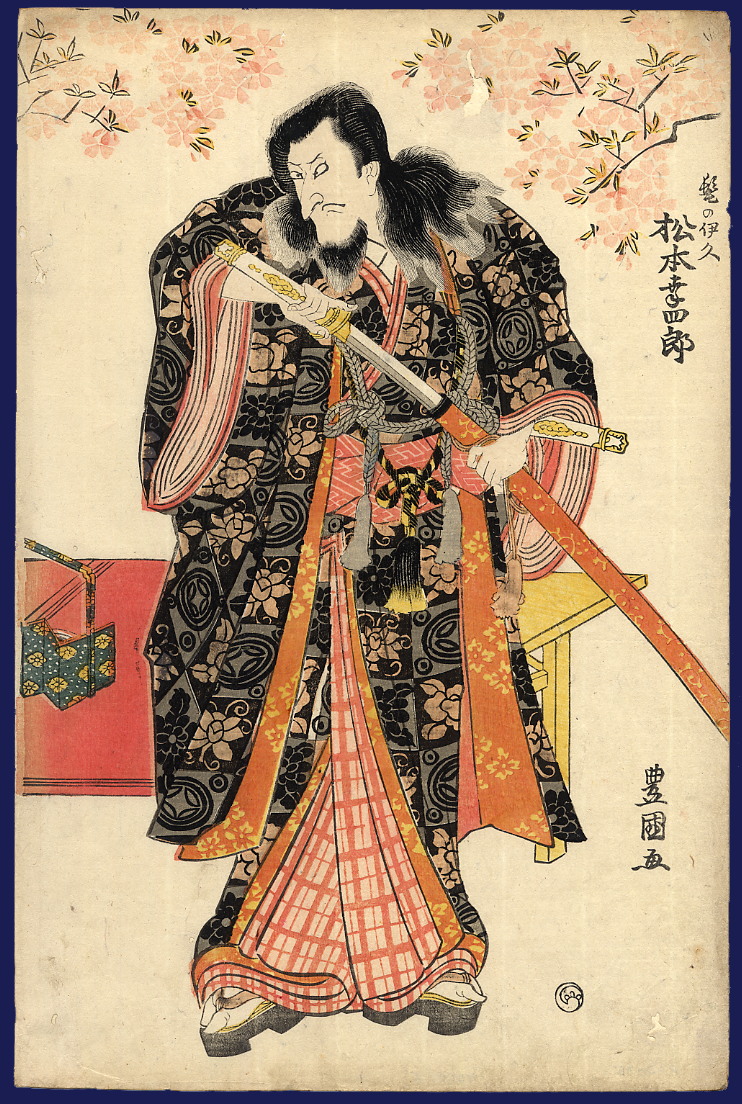
 A lookalike triptych by Kunisada can be found in Ronin Gallery:
A lookalike triptych by Kunisada can be found in Ronin Gallery:
 Data from Kabuki21:
Stage names:
Matsumoto Kôshirô V, Ichikawa Komazô III, Ichikawa Sumizô I
Guild: Kôraiya
Line number: GODAIME (V)
Poetry names: Kinshô, Kinkô
Existence: 1764 ~ 10th day of the 5th lunar month of 1838
Connection:
Father: Matsumoto Kôshirô IV
Sons: Matsumoto Kôshirô VI, Ichikawa Sumizô II
Disciples: Matsumoto Kojirô, Matsumoto Kingo I, Matsumoto Hidejûrô II
Data from Kabuki21:
Stage names:
Matsumoto Kôshirô V, Ichikawa Komazô III, Ichikawa Sumizô I
Guild: Kôraiya
Line number: GODAIME (V)
Poetry names: Kinshô, Kinkô
Existence: 1764 ~ 10th day of the 5th lunar month of 1838
Connection:
Father: Matsumoto Kôshirô IV
Sons: Matsumoto Kôshirô VI, Ichikawa Sumizô II
Disciples: Matsumoto Kojirô, Matsumoto Kingo I, Matsumoto Hidejûrô II
Matsumoto Kôshirô V was one of the Kabuki giants, a senryô yakusha, during the Bunka, Bunsei and Tenpô eras. In his 20's he was a tachiyaku actor excelling in nimaime roles like Soga Jûrô Sukenari in sogamono dramas. He started to perform jitsuaku roles from the 11th lunar month of 1798 and quickly became one of the best actors for villain roles, especially in Tsuruya Nanboku IV's kizewamono. He had a considerable influence on actors like Onoe Kikugorô III or Ichikawa Danjûrô VII. The kata he deviced for some of the most famous roles in Kabuki history, like Gonta ("Sushiya") or Nikki Danjô* ("Meiboku Sendai Hagi") are still used nowadays. "The fifth Kôshirô had a very large nose and his eyes were close together, two facial defects the print artists were fond of depicting, so that this Edo actor is easily picked out in the pictures illustrating the theatre of this time." (Zoë Kincaid in "Kabuki, the Popular Stage of Japan")

 As Japanese Erotic Fantasies put it: "a couple engaged in love-making, their stare fixed outside the picture plane". This is the only image of series that has a reference in available western literature, and the only one found in museum collections: Rijksmuseum Amsterdam (RP-P-1999-2001-16); reference: Fukuda (ed.) (1990), pls. 11-2.
As Japanese Erotic Fantasies put it: "a couple engaged in love-making, their stare fixed outside the picture plane". This is the only image of series that has a reference in available western literature, and the only one found in museum collections: Rijksmuseum Amsterdam (RP-P-1999-2001-16); reference: Fukuda (ed.) (1990), pls. 11-2.
 The scene of this print looks quite similar to that of the Kiyonaga's Sode no maki:
The scene of this print looks quite similar to that of the Kiyonaga's Sode no maki:
 The woman is "a young lady-in-waiting of Shogun's Court or Daimyō's Mansion, enjoying a rare outing from her tedious chores" [Richard Lane]. She is fully dressed in her outer cloak (shikake), white paper hat (agebōshi or tsunokakushi), and toed socks (tabi). A book or maybe, onkotogami (roll of tissues known as 'paper for honourable act' ) is still in the folds of her kimono. She is holding an open fan, either to cover her and her lover's faces from an unsolicited witness or to bring some fresh air to their joined lips. The pair just started their sexual intercourse.
The woman is "a young lady-in-waiting of Shogun's Court or Daimyō's Mansion, enjoying a rare outing from her tedious chores" [Richard Lane]. She is fully dressed in her outer cloak (shikake), white paper hat (agebōshi or tsunokakushi), and toed socks (tabi). A book or maybe, onkotogami (roll of tissues known as 'paper for honourable act' ) is still in the folds of her kimono. She is holding an open fan, either to cover her and her lover's faces from an unsolicited witness or to bring some fresh air to their joined lips. The pair just started their sexual intercourse.
 A scene from medieval times. A courtier in eboshi cap having sex with an aristocratic young woman with a long straight hairstyle (suihatsu).
A scene from medieval times. A courtier in eboshi cap having sex with an aristocratic young woman with a long straight hairstyle (suihatsu).
 Completely naked couple in the moment of ejaculation. Lavish garments with paulownia leaves on a yellow background counterbalance the white bodies on red bedding. The form of a woman's cheeks is telling, but I don't know about what. Maybe her advanced age?
Completely naked couple in the moment of ejaculation. Lavish garments with paulownia leaves on a yellow background counterbalance the white bodies on red bedding. The form of a woman's cheeks is telling, but I don't know about what. Maybe her advanced age?
 The pose of the couple and the overall composition are similar to that of the previous sheet. Though the lovers are dressed, and the woman's hairdo is well kept. The male looks older and the woman - younger.
The pose of the couple and the overall composition are similar to that of the previous sheet. Though the lovers are dressed, and the woman's hairdo is well kept. The male looks older and the woman - younger.
 A man takes a young maid from behind. She clenches the sleeve of her kimono in her teeth; it's either the moment of penetration (beginning of intercourse) or of her orgasm (the end of it).
A man takes a young maid from behind. She clenches the sleeve of her kimono in her teeth; it's either the moment of penetration (beginning of intercourse) or of her orgasm (the end of it).
 This seems to be a forced intercourse between a lackey with extensive bodily hair and a young maid from the same household.
This seems to be a forced intercourse between a lackey with extensive bodily hair and a young maid from the same household.
 This design is very much like the other one presented below, which is described at Japanese Erotic Fantasies on page 136 (pl. 43b) as follows: "The viewer peers through a mosquito net to see a child fast asleep, while his mother or wet-nurse moves towards her partner. On our print there is no child; instead of a sleeping baby, there is a roll of onkotogami. Fewer objects make the overall image concise, almost laconic in comparison with the Ehon hana fubuki (1802) design:
This design is very much like the other one presented below, which is described at Japanese Erotic Fantasies on page 136 (pl. 43b) as follows: "The viewer peers through a mosquito net to see a child fast asleep, while his mother or wet-nurse moves towards her partner. On our print there is no child; instead of a sleeping baby, there is a roll of onkotogami. Fewer objects make the overall image concise, almost laconic in comparison with the Ehon hana fubuki (1802) design:

 A young couple in a moment of true love. He is listening to the beating of her heart.
A young couple in a moment of true love. He is listening to the beating of her heart.
 This is a moment of true love between an old monk and a young samurai. The latter even did not take of his socks (tabi).
This is a moment of true love between an old monk and a young samurai. The latter even did not take of his socks (tabi).
 From Japanese Erotic Fantasies: "Boats played a crucial role in the workings of Yoshiwara, as they were the primary means of transport to the district. During the hot summer months, trips on pleasure boats were also a favourite pastime. Sex aboard a boat is a recurrent theme in shunga".
The last print that I am currently lacking and hunting for:
From Japanese Erotic Fantasies: "Boats played a crucial role in the workings of Yoshiwara, as they were the primary means of transport to the district. During the hot summer months, trips on pleasure boats were also a favourite pastime. Sex aboard a boat is a recurrent theme in shunga".
The last print that I am currently lacking and hunting for:
 I know where it is, but I cannot reach it... yet.
I know where it is, but I cannot reach it... yet. 



Kuroki Matsujiro (黒木松次郎) was born in the village of Itsuki in Kuma district, Kumamoto prefecture, island of Kyushu in Bunka era, 4th year (1807). Since from his childhood he was blessed by great physique and tough strength. He had affection for sumo. At the age of 18 he became a sumo student of Kumamoto Shimakawa Ikuhei and took the name of Toyama Hidekichi (遠山日出吉). At the age of 23 (1830), he entered sumo stables in Kyoto, mastered the art of taming of young horses, and his talents improved. At the age of 31 he went to Edo, and became a disciple of the ōzeki Oitekaze Kitaro of Hirado domain in Hizen province, also from Kyushu island. After that, he changed his name and became Kuroyanagi Matsujiro (黒柳松次郎 – as on the print). In 1847 (Bunka era, 4th year) he distinguished himself by advancing to the first grade, and at the age of 32 he was promoted to ozeki level, becoming sekitori. After changing his name to Kuma-ga-take Inosuke (熊ヶ嶽猪之介 / くまがたけいのすけ) he displayed further efforts, and became one of the strongmen that fermented sumo wrestling in Edo. In 1853 (Kaei era, 6th year) he retired and returned to his village, becoming an employee as a strongman of Sagara domain (相良藩), and worked hard as instructor of the sumo training hall to train successors until 1855 (Ansei era, 2nd year) when he passed away at the age of 48. Even today Kuma-ga-take's home exists in Itsukimura (his native village). Also, on those grounds a descendant of Kuma-ga-take runs minshuku (guest house) that bears the name of "The Kuroki Pension (lodging) ", and tourists come to visit from various parts of Japan. In 2015, tenth month, within the borders of Aoi Aso Shrine there was built a gravestone publicly honoring Kuma-ga-take Inosuke, sumo wrestler from Edo / of Edo period.
| Highest Rank | Maegashira 4 |
| Real Name | Kuroki |
| Birth Date | 1815 |
| Shusshin | Kumamoto-ken, Kuma-gun |
| Death Date | March 6, 1855 (40 years) |
| Heya | Oitekaze |
| Shikona | Kuroyanagi Matsujiro - Kumagatake Isuke |
| Hatsu Dohyo | 1836.02 (Sandanme) |
| Intai | 1853.02 |
On another important sumo history website, I found that Kuroyanagi first appeared at ring in the spring of 1823 (he might have been 16 years old then, which does not seem right). Then, in the winter tournament of 1848 Kuroyanagi took the name Kumagatake. At the spring tournament of 1853 Kumagatake (Kuroyanagi) retired. This is quite consistent so far.
Then, I found Oitekaze Kitaro, allegedly the teacher of Kuroyanagi.| Highest Rank | Ozeki |
| Real Name | SATO Matsujiro (Matsutaro#) |
| Birth Date | 1799 |
| Shusshin | Kanagawa-ken, Tsukui-gun |
| Death Date | May 4, 1865 (66 years) |
| Heya | Oitekaze |
| Shikona | Kuroyanagi Matsujiro - Kuroyanagi Sumiemon - Oitekaze Kitaro |
| Hatsu Dohyo | 1817.10 (Jonokuchi) |
| Intai | 1839.03 |

Artist Koikawa Harumasa (a.k.a. Banki): fl. 1801–18. Wikipedia: Koikawa Harumasa (恋川 春政; active 1800–1820), later called Banki Harumasa (晩器 春政). Associated with Katsukawa school.
Signed: Banki ga (on the bamboo flower container in the background). Censor's seal: kiwame. Mark of unidentified publisher, Genshoku #1017; Marks U084 Ibiko, p. 387.
References:
Jacob Pins #828.


Kitagawa Tsukimaro (Kikumaro): 喜多川 月麿, fl. c. 1794–1836.
Mother is playing with her child: they left playing with shadow lantern for freeing a turtle (Hojo-e, or "Rite for the Release of Living Beings").Signed: Tsukimaro hitsu (月麿筆); Publisher's mark; censor's seal: Kiwame + Yamaguchiya Tôbei gyōji seal (1811-14).


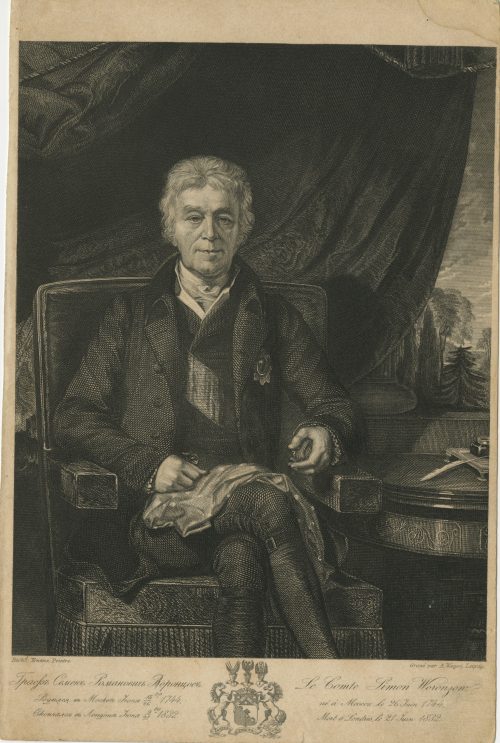
Seated portrait of Russian diplomat Count Semyon Romanovich Vorontsov (Семён Романович Воронцо́в; 26 June 1744 – 9 July 1832). Engraved by August Weger (Born: 1823 in Nürnberg; died: 1892 in Leipzig) from the portrait painted by Richard Evans (1784–1871). Circa 1825-50. Semyon Romanovich Vorontsov, the son of Count Roman Illarionovich and Marfa Ivanovna Surmina, was born on June 15, 1744; Active Privy Councillor; Ambassador to Venice and London from 1784, for over 20 years. Died in London on June 26, 1832.
Inscription: Графъ Семенъ Романовичь Воронцовъ. Родился въ Москвѣ Iюня 15-го/26 1744, Скончался въ Лондонѣ Iюня 9-го/21 1822. | Le Comte Simon Woronzow. né à Moscou le 26 Juin 1744, Mort à Londres le 21 Juin 1832. | Richd. Evans, Peintre. - Gravé par A. Weger, Leipzig. Vorontsov family coat of arms in the middle.
Dimensions: 23 x 15 cm. Ref.: Подробный словарь русских гравированных портретов Д. А. Ровинского, том. 1, 534-540.
 Uncut fan print (uchiwa-e) depicting Onoe Kikugorō IV as Karukaya Dōshin parting from his son, Ishidomaru (played by Ichimura Uzaemon XIII), and Kawarasaki Gonjūrō I as Yamazakiya Yogoro in the kabuki play Karukaya Dōshin Tsukushi no Iezuto [苅萱桑門筑紫𨏍], written by Namiki Sōsuke [並木宗輔] (Japanese, 1695 – 1751) and performed at Ichimuraza [市村座] in 05/1856.
Media: Fan print [団扇絵] (Uchiwa-e); size: 235 x 305 mm.
Actors:
Onoe Kikugorō IV [四代目 尾上菊五郎] (Japanese, 1808 – 1860); other names: Onoe Baikō IV, Onoe Eizaburō III, Onoe Kikue, Nakamura Tatsuzō, Nakamura Kachō.
Onoe Kikugorō V [五代目尾上菊五郎] (Japanese, 1844 – 1903 other names: Onoe Baikō V, Ichimura Kakitsu IV, Ichimura Uzaemon XIII [十三代目市村羽左衛門], Ichimura Kurōemon.
Ichikawa Danjūrō IX [市川団十郎] (Japanese, 1838 – 1903); other names: Kawarasaki Sanshō, Kawarasaki Gonnosuke VII, Kawarasaki Gonjūrō I, Kawarasaki Chōjūrō III.
Plot: It was a popular belief at one time that jealous women had their hair transformed into writhing serpents and Kato Sayemon Shige-Uji, a daimyo of Tsukushi, a much-married man, suffered from the delusion that his wife was so affected. He fled to the mountains to escape her and led the life of a hermit under the name of Karukaya Doshin [苅萓道心]. One day, on Mount Kōya (高野山, Kōyasan) Karukaya meets a young man who was wandering in the mountains. Being questioned, the youth tells his name, Ishidomaru, and elicits the information that he is seeking his lost father. Karukaya then recognizes the boy as his own son, but firm in the resolve to remain lost to the world, he refrains from disclosing himself, and bids the youth return home.
Provenance: Paul F. Walter (American, 1935 – 2017).
Ref.:
Uncut fan print (uchiwa-e) depicting Onoe Kikugorō IV as Karukaya Dōshin parting from his son, Ishidomaru (played by Ichimura Uzaemon XIII), and Kawarasaki Gonjūrō I as Yamazakiya Yogoro in the kabuki play Karukaya Dōshin Tsukushi no Iezuto [苅萱桑門筑紫𨏍], written by Namiki Sōsuke [並木宗輔] (Japanese, 1695 – 1751) and performed at Ichimuraza [市村座] in 05/1856.
Media: Fan print [団扇絵] (Uchiwa-e); size: 235 x 305 mm.
Actors:
Onoe Kikugorō IV [四代目 尾上菊五郎] (Japanese, 1808 – 1860); other names: Onoe Baikō IV, Onoe Eizaburō III, Onoe Kikue, Nakamura Tatsuzō, Nakamura Kachō.
Onoe Kikugorō V [五代目尾上菊五郎] (Japanese, 1844 – 1903 other names: Onoe Baikō V, Ichimura Kakitsu IV, Ichimura Uzaemon XIII [十三代目市村羽左衛門], Ichimura Kurōemon.
Ichikawa Danjūrō IX [市川団十郎] (Japanese, 1838 – 1903); other names: Kawarasaki Sanshō, Kawarasaki Gonnosuke VII, Kawarasaki Gonjūrō I, Kawarasaki Chōjūrō III.
Plot: It was a popular belief at one time that jealous women had their hair transformed into writhing serpents and Kato Sayemon Shige-Uji, a daimyo of Tsukushi, a much-married man, suffered from the delusion that his wife was so affected. He fled to the mountains to escape her and led the life of a hermit under the name of Karukaya Doshin [苅萓道心]. One day, on Mount Kōya (高野山, Kōyasan) Karukaya meets a young man who was wandering in the mountains. Being questioned, the youth tells his name, Ishidomaru, and elicits the information that he is seeking his lost father. Karukaya then recognizes the boy as his own son, but firm in the resolve to remain lost to the world, he refrains from disclosing himself, and bids the youth return home.
Provenance: Paul F. Walter (American, 1935 – 2017).
Ref.:

Uncut fan print (uchiwa-e), 295 x 230 mm, depicting kabuki actor Bandō Shūka I as Shirai Gonpachi (白井権八) reading a scroll by the light of a lantern. From the series A Parody of the Five Chivalrous Commoners; a Cup of Sake From Their Fans (Mitate gonin otoko, go-hiiki no omoizashi). According to Paul Griffith, the term omoizashi refers to the act of pouring a cup of sake for one's chosen partner, here giving an impression of intimacy and affection between famous actors and their patrons.
Actor: Bandō Shūka I [初代坂東しうか] (Japanese, 1813-1855); other names: Bandō Tamasaburō I, Bandō Mitsugorō V (posthumously). The print was probably published by some unknown Yama-Ta (Marks U421b). Double nanushi censor seals and date seal: Muramatsu and Fuku, Kaei 5, 2nd month (2/1852). As Kabuki Encyclopedia put it: "Gonpachi. A parasite. From the character named Shirai Gonpachi who lives at the home of Banzui Chōbei and sponges off him" (An English-Langauge Adaptation of Kabuki Jiten. Samuel L. Leiter. Greenwood Press, 1979, pp. 26, 98-9). There were many kabuki plays based on the story of the lovers Miura-ya Komurasaki and Shirai Gonpachi. (See: [LIB-2226.2019] Algernon Bertram Freeman-Mitford. Tales of Old Japan. — London: Macmillan and Co., 1883). Ref.: Art shop Ezoshi Ukiyoe new collection news, vol. 66, 2023.1 (Jan) # 31, p.8.
Promotional fan for a hairpin shop, with a poem by Ichikawa Danjuro VII, signed Hakuen.
Date seal plus rectangular kiwame seal: Bunsei 8 (1825).
Size: Fan print. Uchiwa-e (27.5 x 21.1 cm) Publisher seal: Maru-To (2) (Marks U204). Date seal plus rectangular kiwame seal: Bunsei 8 (1825).
Signed: Ichiyosai Kuniyoshi ga in a red cartouche and sealed with paulownia (kiri mon).
Date seal and double nanushi censor seals: Fuku & Muramatsu, 1853 (Kaei 6, 2nd month).
Size: Uchiwa-e (untrimmed fan print) 296 x 230 mm.
 SVJP-0303.2019 |

Signed: Toyokuni ga [豊国 画] in a red toshidama cartouche.
Publisher: Kojimaya Jūbei (c. 1797-1869), seal: Hanmoto, Jū [板元, 十] (Marks 19-043 | 264c).
Double nanushi censor seals: Mera & Watanabe – Kaei 4 (1851).
Uncut fan print (uchiwa-e), 298 x 228 mm depicting a young woman adjusting her hairpin and holding a portable lantern (andon) on a marine background with the full moon, nearby boats and distant cormorant fishers.
A young woman reading a book in the light of a lamp. Series: Arigataki miyo no kage-e (Shadow Pictures of an Auspicious Age). There are five known prints, half-length portraits of beauties, in this series, designed by Kunisada in ca. 1844. Another print from the series in this collection: SVJP-0306.2020: A young woman adjusting her hairpins in the light of a paper lantern.
Signed: Kōchōrō Toyokuni ga (香蝶楼豊国画).
Publisher: Maruya Kiyojiro.
Size: Vertical Ōban (37.5 x 25.4 cm).
A young woman adjusting her hairpins in the light of a paper lantern. Series: Arigataki miyo no kage-e (Shadow Pictures of an Auspicious Age). There are five known prints, half-length portraits of beauties, in this series, designed by Kunisada in ca. 1844. Another print from the series in this collection: SVJP-0309.2020: A young woman reading a book in the light of a lamp.
Signed: Kōchōrō Toyokuni ga (香蝶楼豊国画). Publisher: Maruya Kiyojiro.
Size: Vertical Ōban (37.5 x 25.4 cm). Utagawa (歌川) SOLD
A young woman adjusting her hairpin on a balcony during the Tanabata festival, as inscribed on the white folding fan: [七夕] (Tanabata).
Inscription on the blue book (print title): Early autumn [はつ秋や] (hatsu akiya), inscription on the purple book (series title): Short love songs, second volume [端唄の意 二編] (Hauta no kokoro nihen). According to Marks (2010), Hauta no kokoro nihen series of fan prints was published by Ibaya in 1858 (p. 267|P6871).
The series refers to love songs of a certain type popular in late Edo. They were performed with the accompaniment of a shamisen, “Seven herbs of autumn, the song of the insects is not heard; the bodies of lightning bugs are burnt, and the precious writings of love are getting thinner like the song of the insects as I am waiting for you. So, on an early autumn evening, I spot the glitter of a lightning bug that lingered among the autumn grasses, and while listening to the pine cricket, I am singing with my heart troubled by love". [Tokyo National Museum; translation provided by Elena Varshavsky].Tanabata [たなばた] or [七夕] – meaning "Evening of the seventh", also known as the Star Festival [星祭] (Hoshi matsuri) – is a Japanese festival originating from the Chinese Qixi Festival. One popular Tanabata custom is to write one's wishes on a piece of paper and hang that piece of paper on a specially erected bamboo tree, in the hope that the wishes become true.

A man with a shaved head (a monk), holding a paper lantern and an umbrella, walks with a young woman (a geisha) in the rain.
SIGNED: Gototei Kunisada ga [五渡亭国貞画]
Censor's seals: kiwame, futakata.
Blockcutter's mark: Seizô tô [改印:極、貳方]
MFA ACCESSION NUMBER 11.15150; MFA dating: about 1815–21 (Bunka 12–Bunsei 4);
Size: Vertical Ōban (382 x 260 mm). SOLD
 |
 |
|---|


Title: Suzume fukube [美人団扇絵] (Sparrow and gourds).
Series: Kacho awase [花鳥合] (Collection of flowers and birds).
Publisher: Aritaya Seiemon [有田屋 清右衛門] (Japanese, fl. c. 1830 – 1862); Seal: Marks 17-011 | 014d.Signed: Ichiyosai Kuniyoshi ga in a red cartouche and sealed with paulownia crest (kiri mon).
Size: Uchiwa-e (untrimmed fan print) 296 x 230 mm.
Double nanushi censor seals: Kinugasa & Watanabe, Kaei 2-3 (1849–50).
Ref.: Kuniyoshi Project.



